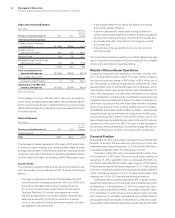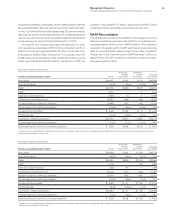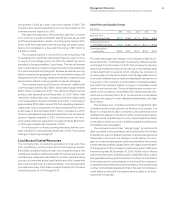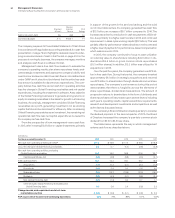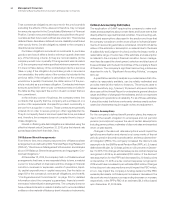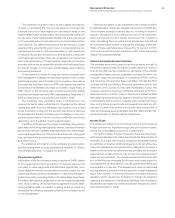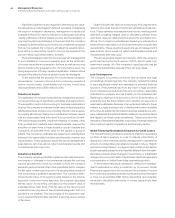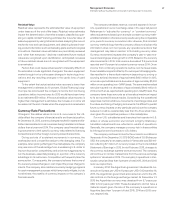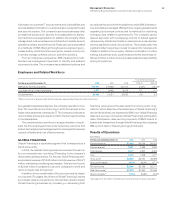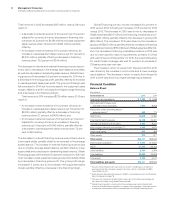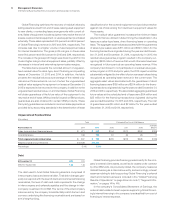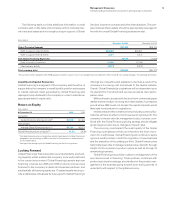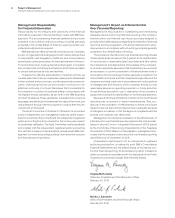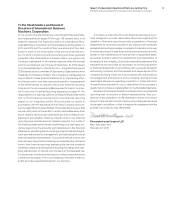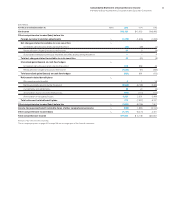IBM 2015 Annual Report Download - page 69
Download and view the complete annual report
Please find page 69 of the 2015 IBM annual report below. You can navigate through the pages in the report by either clicking on the pages listed below, or by using the keyword search tool below to find specific information within the annual report.67
Management Discussion
International Business Machines Corporation and Subsidiary Companies
Residual Value
Residual value represents the estimated fair value of equipment
under lease as of the end of the lease. Residual value estimates
impact the determination of whether a lease is classified as oper-
ating or capital. Global Financing estimates the future fair value of
leased equipment by using historical models, analyzing the current
market for new and used equipment, and obtaining forward-look-
ing product information such as marketing plans and technological
innovations. Residual value estimates are periodically reviewed
and “other than temporary” declines in estimated future residual
values are recognized upon identification. Anticipated increases
in future residual values are not recognized until the equipment
is remarketed.
Factors that could cause actual results to materially differ from
the estimates include significant changes in the used-equipment
market brought on by unforeseen changes in technology inno-
vations and any resulting changes in the useful lives of used
equipment.
To the extent that actual residual value recovery is lower than
management’s estimates by 10percent, Global Financing’s seg-
ment pre-tax income and the company’s income from continuing
operations before income taxes for 2015 would have been lower
by an estimated $79million. If the actual residual value recovery is
higher than management’s estimates, the increase in income will
be realized at the end of lease when the equipment is remarketed.
Currency Rate Fluctuations
Changes in the relative values of non-U.S. currencies to the U.S.
dollar affect the company’s financial results and financial position.
At December31, 2015, currency changes resulted in assets and lia-
bilities denominated in local currencies being translated into fewer
dollars than at year-end 2014. The company uses financial hedg-
ing instruments to limit specific currency risks related to financing
transactions and other foreign currency-based transactions.
During periods of sustained movements in currency, the
marketplace and competition adjust to the changing rates. For
example, when pricing offerings in the marketplace, the company
may use some of the advantage from a weakening U.S. dollar to
improve its position competitively, and price more aggressively to
win the business, essentially passing on a portion of the currency
advantage to its customers. Competition will frequently take the
same action. Consequently, the company believes that some of
the currency-based changes in cost impact the prices charged to
clients. The company also maintains currency hedging programs
for cash management purposes which temporarily mitigate, but do
not eliminate, the volatility of currency impacts on the company’s
financial results.
The company translates revenue, cost and expense in its non-
U.S. operations at current exchange rates in the reported period.
References to “adjusted for currency” or “constant currency”
reflect adjustments based upon a simple constant currency math-
ematical translation of local currency results using the comparable
prior period’s currency conversion rate. However, this constant
currency methodology that the company utilizes to disclose this
information does not incorporate any operational actions that
management may take in reaction to fluctuating currency rates.
Currency movements impacted the company’s year-to-year reve-
nue and earnings per share growth in 2015. Based on the currency
rate movements in 2015, total revenue decreased 11.9percent as
reported and 4.1percent at constant currency versus 2014. On an
income from continuing operations before income taxes basis,
these translation impacts offset by the net impact of hedging activ-
ities resulted in a theoretical maximum (assuming no pricing or
sourcing actions) decrease of approximately $900million in 2015,
on an as-reported basis and a decrease of approximately $1,000
million on an operating (non-GAAP) basis. The same mathematical
exercise resulted in a decrease of approximately $400million in
2014 on both an as-reported and operating (non-GAAP) basis. The
company views these amounts as a theoretical maximum impact
to its as-reported financial results. Considering the operational
responses mentioned above, movements of exchange rates, and
the nature and timing of hedging instruments, it is difficult to predict
future currency impacts on any particular period, but the company
believes it could be substantially less than the theoretical maxi-
mum given the competitive pressure in the marketplace.
For non-U.S. subsidiaries and branches that operate in U.S.
dollars or whose economic environment is highly inflationary,
translation adjustments are reflected in results of operations.
Generally, the company manages currency risk in these entities
by linking prices and contracts to U.S. dollars.
The company continues to monitor the economic conditions in
Venezuela. At the December31, 2015 SICAD rate of 13.5 Bolivar per
USD, the company’s net asset position in Venezuela was $29mil-
lion reflecting $7million of currency losses in the Consolidated
Statement of Earnings in 2015. In mid-February 2016, changes to
the currency exchange systems were announced. The company
will continue to monitor transactions from the various exchange
systems in Venezuela in 2016. The company’s operations in Ven-
ezuela comprised less than 1percent of total 2015, 2014 and 2013
revenue, respectively.
In January 2014, the Argentinian government devalued its cur-
rency from 6pesos per USD to 8pesos per USD. On December16,
2015, the Argentinian government announced an end to the offi-
cial controls on the foreign exchange market. At December31,
2015 the Argentinian currency was devalued from 9.7pesos per
USD to 12.9pesos per USD. These devaluations did not have a
material impact given the size of the company’s operations in
Argentina (less than 1percent of total 2015, 2014 and 2013 reve-
nue, respectively).



